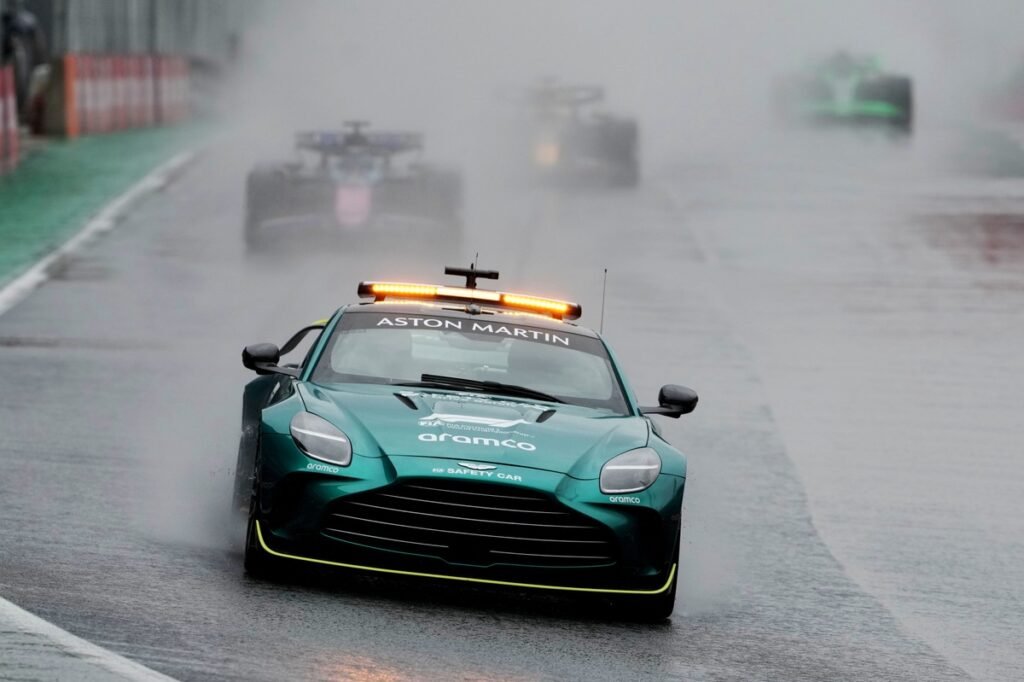Formula 1’s wet and wild 2024 Brazilian Grand Prix had just reached a critical strategy point when it was interrupted – first by a safety car activation, then Franco Colapinto’s red flag-causing crash.
The safety car was called into action on lap 30 of 69 last Sunday, just as Alpine’s Esteban Ocon was putting chunks of time into eventual winner Max Verstappen.
Lando Norris had also just finally passed long-time Mercedes leader George Russell and was homing in on Pierre Gasly in the second Alpine using his McLaren’s fresher second set of intermediates. Norris’s Red Bull title rival was metres ahead.
At this stage, three-quarters of the field was on the green-walled rubber, while above very dark clouds were depositing heavier rain onto Interlagos compared to anything that had come down in the race to that point or qualifying early on Sunday morning.
With just five drivers running the extreme wet tyres – taken by Sergio Perez and Zhou Guanyu, the RB drivers and Nico Hulkenberg during their respective virtual safety car stops and services shortly just after this phase – and no drivers yet off-track, it raised two interlined questions.
Why was any intervention was necessary? And why was this first done with just the safety car?
“There were a couple of surprises for me in that race – one was that it wasn’t red-flagged sooner,” Red Bull team boss Christian Horner said afterwards. “There were a lot of drivers that were feeling that the conditions were too unsafe.”
The red flag only came when Colapinto crashed his Williams early on the pit straight climb while running at safety car delta speeds on the 32nd tour – after he had passed the Aston Martin Vantage earlier in the lap.
Lawson passed Hamilton moments before the safety car was called
Photo by: Lubomir Asenov / Motorsport Images
Afterwards, when discussing “a point when one could have made a direct comparison between the two types of [wet] tyre over a long stint”, Pirelli motorsport boss Mario Isola claimed, “the neutralisation [was] caused when visibility was deemed too poor”.
However, Autosport understands from FIA sources that the risk of aquaplaning in the suddenly increased standing water – and amid the many rivers that rapidly run across the dramatically undulating Sao Paulo track – was what really forced race control to take action with the safety car.
The even further reduced visibility compared to the race to this point was a worry for officials too, but not the primary concern, with the plan to have the pack lap for a few tours behind the safety car in an expected five-minute burst of intense rain, before green-flag racing could be resumed.
Colapinto’s crash undid this plan and wrecked the recovering chances of Norris, who had been briefly rocketing back into a potentially leading position with his much fresher inters compared to those on the three eventual podium finishers ahead at this stage.
Ocon, Verstappen and Gasly were then able to switch their worn tyres off under the ensuring red flag stoppage without losing places due to F1’s long-standing rules allowance in such circumstances.
Norris called this “a silly rule that no one agrees with”.
“But you’ll always agree with it when it benefits you,” he added, “So, every driver has said they don’t agree with it and want it changed.”
Watch: How the Right Calls Led to Verstappen’s Incredible Comeback – F1 Brazil GP Race Reaction
Read the full article here


